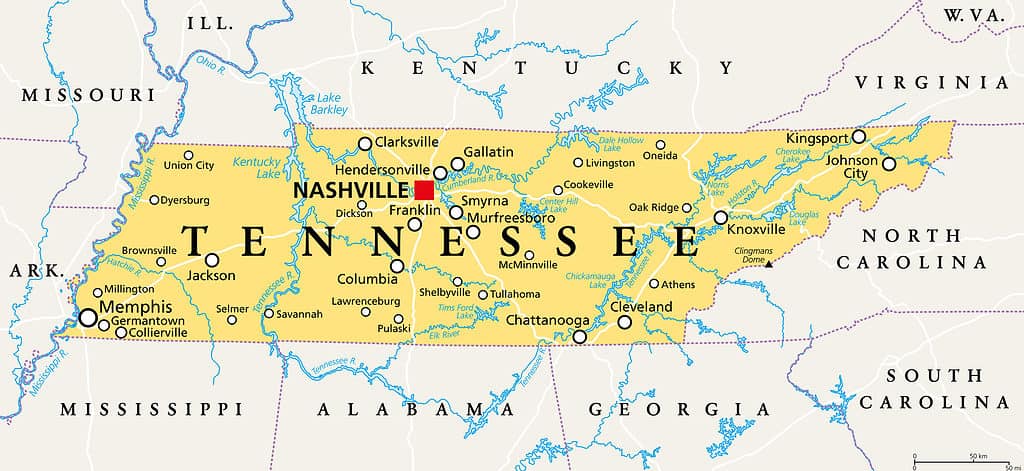Tennessee is a beautiful state, full of natural and man-made attractions for visitors. From hiking in the Great Smoky Mountains National Park to exploring the bustling city of Nashville, there are plenty of things to see and do when visiting Tennessee. Get close to nature by taking a cruise on one of the many rivers running through the state. Visit historical sites such as Graceland or Fort Loudoun State Historic Park to learn more about Tennessee’s rich history. Marvel at spectacular views from Lookout Mountain and Clingmans Dome, or take a drive along The Trace Parkway. Whether you’re looking for outdoor adventure or cultural exploration, Tennessee has something for everyone!
Where is Tennessee Located?
Tennessee is located in the southeastern region of the United States. It is bordered by Kentucky to the north, Virginia to the northeast, North Carolina to the east, Georgia, Alabama, and Mississippi to the south, and Arkansas and Missouri to the west. Tennessee has an estimated population of 6.77 million people and covers an area of 42,143 square miles – making it slightly larger than South Korea but smaller than West Virginia. With Nashville as its capital city,
Tennessee is known for its rich history and culture that blend southern charm with a vibrant urban atmosphere. The state also boasts some of America’s most beautiful scenery, from rolling hills filled with forests in East Tennessee to wide open plains in Middle Tennessee, all leading into Delta country along its western border where music legends like Elvis Presley were born!

Tennessee is located in the southeastern region of the United States and has an estimated population of 6.77 million.
©iStock.com/PeterHermesFurian
Tennessee: Founding of the State
The state of Tennessee was founded on June 1, 1796. It is the 16th state to join the United States, located in the country’s southeastern region. The original 13 colonies were among those who ceded land from their own territories to create Tennessee.
The settlers that moved into this area brought with them a diverse background that shaped the culture and identity of what would become an important part of American history. One example of this was their adoption of agriculture-based industries such as cotton farming which would eventually lead to Nashville becoming known as “the Athens of America” due to its focus on education and cultural enrichment activities related to these industries. Other industries, like iron mining, also had a large impact on how people lived during this time period in Tennessee’s early days as a state.
In 2021, Tennessee celebrated its 225th year of statehood. In Nashville, there was a special lecture at the Tennessee State Library & Archives looking at why its state motto is the “Volunteer State.” Historically, Tennesseans were known for being willing to step forward and serve in war times. The nickname originated during the War of 1812, in which volunteer soldiers from the Tennessee militia were lauded for their military spirit. They continued to cement their reputation during the Mexican American War, where 30,000 Tennessee men answered a call from President James K. Polk (of Tennessee) for 2,600 able volunteers.
Tennessee: Geography and Climate
The state’s geography includes vast areas of both mountainous terrains as well as flat plains. This diverse landscape provides a unique climate that varies from region to region throughout the state. In general, temperatures can range from hot and humid in the summer months to cold and wet during the winter months. Tennesseans experience all four seasons but typically have mild winters compared to other parts of the country due to its location near the Gulf Stream current, which impacts weather patterns across much of eastern North America.

Tennessee’s geography includes vast areas of both mountainous terrains as well as flat plains.
©Kevin Ruck/Shutterstock.com
Tennessee: Languages and Religions
Tennessee is home to a variety of languages and religions. The official language in the state is English, but many people also speak Spanish, German, French, and Dutch. Tennessee has diverse religious communities, including Christianity (Baptist and Methodist being the two largest denominations), Islam, Judaism, Hinduism, Buddhism, and other faiths. Each religion brings unique traditions to the region that are reflected in their respective places of worship as well as community events throughout the year. Additionally, there are plenty of secular activities, such as music festivals or art galleries, that often bring together members from different backgrounds to celebrate common interests regardless of faith.
Tennessee: Cuisine and Culture
Tennessee has a vibrant and flavorful culture that is reflected in its cuisine. Southern dishes like fried chicken, barbecue, and cornbread are staples of the state’s culinary tradition. Tennessee also boasts some unique foods, such as Nashville hot chicken and moonshine-soaked chocolates.
In addition to food, music is an integral part of Tennessee’s culture; Country music originated here with legends such as Johnny Cash, Dolly Parton, Elvis Presley, Loretta Lynn, and many more. Tennessee also prides itself on being a leader in the craft beer movement, with multiple award-winning breweries across the state. From rich cultural heritage to iconic landmarks like Graceland or The Grand Ole Opry House, there’s something for everyone when it comes to exploring all that Tennessee has to offer!

Tennessee is home to iconic landmarks such as Elvis Presley’s Graceland.
©Rolf_52/Shutterstock.com
Flag of Tennessee: A Description
The flag of Tennessee is composed of a red field bordered by a thin white stripe to the far right. The edge of the flag farthest from the pole has a thicker band of bright blue. In the center of the flag is a blue circle with white trim. Inside the blue circle are three white 5-point stars.

The three stars and blue circle in the flag of Tennessee stand for unity.
©rarrarorro/Shutterstock.com
Flag of Tennessee: Symbolism
The symbolism behind the design of this flag is rich and meaningful. The three stars represent the three regions of Tennessee: East Tennessee, Middle Tennessee, and West Tennessee. They stand for unity among all Tennesseans despite their geographical differences. The blue in an infinite circle represents the unity of the state that cannot be broken. These are values held dear by Tennesseans everywhere.
Flag of Tennessee: History of the Flag
The current flag was adopted by the General Assembly of Tennessee in 1905 and designed by Colonel LeRoy Reeves. When Reeves was asked about the three stars, he said they represented the three grand divisions of the state. There has been much deliberation on this topic. Some believe that division refers to the regions of the west, central plateau, and Appalachian areas. Some believe the three presidents, Andrew Jackson, James Polk, and Andrew Johnson, lived in Tennessee. Still, others posit that the three stars refer to Tennessee being the third state to join the union after the original 13.
Flag of Tennessee: Variations
1897 The first confirmed official flag was adopted in 1897. It showed diagonal stripes of red, blue, and white, with the inscription “The Volunteer State” in yellow (the state nickname) blazoned through the blue. It also depicted the number 16 printed in the white stripe, indicating the order of admission of Tennessee to statehood.
Seal of Tennessee
The Great Seal of the State of Tennessee is the official stamp of the state and is used by the Secretary of State and Governor for official documents. It was written into the Constitution of the State of Tennessee in 1796 but was adopted in 1801.
The Seal is a yellow circle with the words “The Great Seal of the State of Tennessee 1796: encircling it. Inside the circle, filling the upper half, is a plow, a cotton plant, and a bundle of wheat. Below the symbols is the word Agriculture in the center. At the bottom of the circle, a flat-bottomed boat floating in the water is depicted with the word Commerce under it.

The Great Seal of the State of Tennessee is the official stamp of the state used by the Secretary of State and Governor for official documents.
©iStock.com/Roki Rodic
Click here to learn about every single flag in the world!
Up Next
- The Flag of Cuba: History, Meaning, and Symbolism
- The Flag of the United States of America: History, Meaning, and Symbolism
- The Flag of Uzbekistan: History, Meaning, and Symbolism
The photo featured at the top of this post is © iStock.com/Kamlesh Suthar
Sources
- Tennessee Government / Accessed December 11, 2022
- Tennessee Secretary of State / Accessed December 11, 2022
- Tennessee Military Department / Accessed December 11, 2022
- Raven: A Journal of Vexillology / Accessed December 11, 2022
- JSTOR / Accessed December 11, 2022
Thank you for reading! Have some feedback for us? Contact the AZ Animals editorial team.







